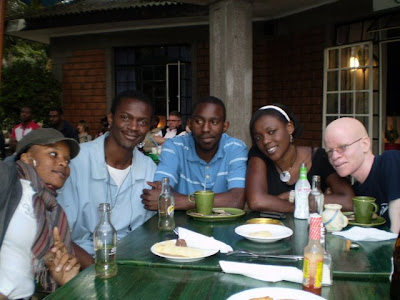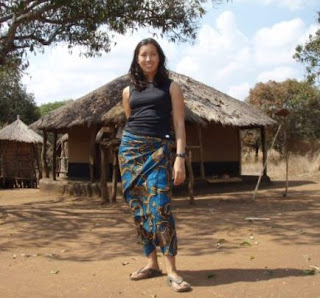Just thought I'd share some assorted photos from my last month in Malawi . . .
 Photo 1: In May and June I went on many field visits with the cassava project. We talked to farmers, checked on progress, visited fields, etc. In this photo I'm standing with Mr. Chamaza-Banda, a TLC field coordinator, and a girl whose name I quite unfortunately have forgotten, but who works as a volunteer on the project. Volunteers assist the field coordinators in providing support to the farmers.
Photo 1: In May and June I went on many field visits with the cassava project. We talked to farmers, checked on progress, visited fields, etc. In this photo I'm standing with Mr. Chamaza-Banda, a TLC field coordinator, and a girl whose name I quite unfortunately have forgotten, but who works as a volunteer on the project. Volunteers assist the field coordinators in providing support to the farmers.
Photo 2: In early July, I had a series of EWB meetings to attend. Here I am holding a session by the lake - not a bad spot to spend a week.

Photo 3: Near the lodge we stayed at for the meetings was the Malawi cichlid centre. Malawi cichlids are collected at a few key points on the lake, and brought back to the centre where they are sorted and then kept in tanks until being sold. If you go to the centre directly, you can buy any fish there for 200Mk ($1.40), but no one would give me an indication of how much they cost when they're shipped overseas, which is where the majority of the fish are sent.
Photo 4: My tour guide at the cichlid centre

Photo 5: I have undoubtedly seen more stunning sunsets during my time here than I had in all my life previously.
 Photo 6: Supports from an old pier (that's what I assume they area anyway) in Senga Bay, Malawi
Photo 6: Supports from an old pier (that's what I assume they area anyway) in Senga Bay, Malawi Photo 7: The Southern Africa EWB crew
Photo 7: The Southern Africa EWB crew Photo 8: A couple weekends ago I joined a fellow EWBer, John Paul Portelli, on a short village stay. John Paul was rather intrigued by how strongly the children took to me - as a guy, he had never had nearly as much success interacting with the women and children as I am able to have. Quite unfortunate, really, as anyone who knows me knows that I'm a little hopeless in interacting with children, while he is fantastic at it!
Photo 8: A couple weekends ago I joined a fellow EWBer, John Paul Portelli, on a short village stay. John Paul was rather intrigued by how strongly the children took to me - as a guy, he had never had nearly as much success interacting with the women and children as I am able to have. Quite unfortunate, really, as anyone who knows me knows that I'm a little hopeless in interacting with children, while he is fantastic at it! Photo 9: Hanging out on top of a hill
Photo 9: Hanging out on top of a hill Photo 12: John Paul making mud bricks. The bricks are formed using the mould (as shown) and then left in the sun to dry for sometime before being "burnt" in an oven, to set them. Burnt bricks use a lot of wood to be produced, and are therefore yet another strain on Malawi's meager wood resources. Nevertheless, burnt bricks are much more popular than the alternatives (such as concrete blocks or other options, which are vastly more popular in neighbouring countries) because the first president of Malawi, Kamuzu-Banda, put in place policies to promote small scale burnt brick production as a means of increasing incomes in the rural areas.
Photo 12: John Paul making mud bricks. The bricks are formed using the mould (as shown) and then left in the sun to dry for sometime before being "burnt" in an oven, to set them. Burnt bricks use a lot of wood to be produced, and are therefore yet another strain on Malawi's meager wood resources. Nevertheless, burnt bricks are much more popular than the alternatives (such as concrete blocks or other options, which are vastly more popular in neighbouring countries) because the first president of Malawi, Kamuzu-Banda, put in place policies to promote small scale burnt brick production as a means of increasing incomes in the rural areas. Photo 15: Last week I went to visit my housemate Bon at his work - the National Food Reserve Agency. Malawi's national grain (i.e. maize) reserve stocks are kept in a few different silo complexes around the country. Bon works as a Quality Control Officer at the main depot in Lilongwe, where 48 silos are located.
Photo 15: Last week I went to visit my housemate Bon at his work - the National Food Reserve Agency. Malawi's national grain (i.e. maize) reserve stocks are kept in a few different silo complexes around the country. Bon works as a Quality Control Officer at the main depot in Lilongwe, where 48 silos are located. Photo 17: As I've mentioned many times before, Malawi's main export crop is tobacco. While some tobacco farmers work on contract with the leaf buying companies (an intermediate step between farmers and the cigarette manufacturers) the majority sell their tobacco at one of 3 auction floors located in Malawi. The auction floors in Lilongwe are the biggest. It is a rather chaotic place! Edgar works for a leaf grading company, and kindly brought me for a tour of the facility.
Photo 17: As I've mentioned many times before, Malawi's main export crop is tobacco. While some tobacco farmers work on contract with the leaf buying companies (an intermediate step between farmers and the cigarette manufacturers) the majority sell their tobacco at one of 3 auction floors located in Malawi. The auction floors in Lilongwe are the biggest. It is a rather chaotic place! Edgar works for a leaf grading company, and kindly brought me for a tour of the facility.















































